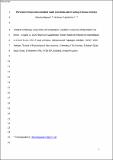Files in this item
Persistent females and compliant males coordinate alarm calling in Diana monkeys
Item metadata
| dc.contributor.author | Stephan, Claudia | |
| dc.contributor.author | Zuberbühler, Klaus | |
| dc.date.accessioned | 2017-10-27T23:31:52Z | |
| dc.date.available | 2017-10-27T23:31:52Z | |
| dc.date.issued | 2016-11-07 | |
| dc.identifier | 247180862 | |
| dc.identifier | 1914f10d-b966-460b-881b-f6af801a293e | |
| dc.identifier | 84994438035 | |
| dc.identifier | 000387835700026 | |
| dc.identifier.citation | Stephan , C & Zuberbühler , K 2016 , ' Persistent females and compliant males coordinate alarm calling in Diana monkeys ' , Current Biology , vol. 26 , no. 21 , pp. 2907-2912 . https://doi.org/10.1016/j.cub.2016.08.033 | en |
| dc.identifier.issn | 0960-9822 | |
| dc.identifier.other | RIS: urn:B73FC60DA33EB54BF93C196946B34FE6 | |
| dc.identifier.other | ORCID: /0000-0001-8378-088X/work/64360677 | |
| dc.identifier.uri | https://hdl.handle.net/10023/11937 | |
| dc.description | This work was funded by the European Research Council under the European Union’s Seventh Framework Programme (FP7/2007-2013)/ERC grant agreement number 283871 and the Swiss National Science Foundation (project 310030_143359). | en |
| dc.description.abstract | Sexual dimorphisms in animal vocal behavior have been successfully explained by sexual selection theory (e.g., mammals [1–5]; birds [6, 7]; anurans [8, 9]), but this does not usually include alarm calls, which are thought to be the product of kin or individual selection (e.g., [10, 11]). Here, we present the results of playback experiments with wild Diana monkeys, a species with highly dimorphic predator-specific alarms, to investigate the communication strategies of males and females during predator encounters. First, we simulated predator presence by broadcasting vocalizations of their main predators, leopards or eagles. We found that males only produced predator-specific alarms after the females had produced theirs, in response to which the females ceased alarm calling. In a second experiment, we created congruent and incongruent situations, so that the calls of a predator were followed by playbacks of male or female alarms with a matching or mismatching referent. For congruent conditions, results were the same as in the first experiment. For incongruent conditions, however, the males always gave predator-specific alarms that referentially matched the females’ calls, regardless of the previously displayed predator. In contrast, females always gave predator-specific alarms that matched the predator type, regardless of their own male’s subsequent calls. Moreover, the females persistently continued to alarm call until their own male produced calls with the matching referent. Results show that males and females attend to the informational content of each other’s alarm calls but prioritize them differently relative to an experienced external event, a likely reflection of different underlying selection pressures. | |
| dc.format.extent | 6 | |
| dc.format.extent | 1642556 | |
| dc.language.iso | eng | |
| dc.relation.ispartof | Current Biology | en |
| dc.subject | Diana monkeys | en |
| dc.subject | Sexual selection | en |
| dc.subject | Alarm calls | en |
| dc.subject | Vocal conformity | en |
| dc.subject | Coordinated acoustic communication | en |
| dc.subject | QH301 Biology | en |
| dc.subject | BF Psychology | en |
| dc.subject | NDAS | en |
| dc.subject.lcc | QH301 | en |
| dc.subject.lcc | BF | en |
| dc.title | Persistent females and compliant males coordinate alarm calling in Diana monkeys | en |
| dc.type | Journal article | en |
| dc.contributor.institution | University of St Andrews. School of Psychology and Neuroscience | en |
| dc.contributor.institution | University of St Andrews. Institute of Behavioural and Neural Sciences | en |
| dc.contributor.institution | University of St Andrews. Centre for Social Learning & Cognitive Evolution | en |
| dc.identifier.doi | 10.1016/j.cub.2016.08.033 | |
| dc.description.status | Peer reviewed | en |
| dc.date.embargoedUntil | 2017-10-27 |
This item appears in the following Collection(s)
Items in the St Andrews Research Repository are protected by copyright, with all rights reserved, unless otherwise indicated.

